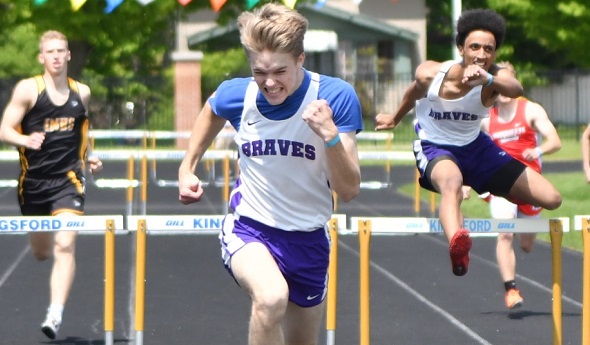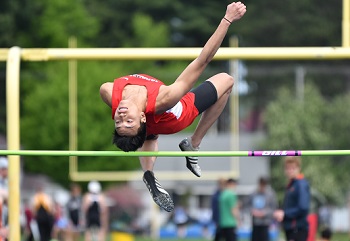
Track Gaining Speed Toward Future with Electronic Starting Devices
By
Steve Vedder
Special for MHSAA.com
May 23, 2023
Aubrey Greenfield thinks it might be the perfect time to reevaluate 130 years of tradition.
For a number of reasons, from technical to personal, the Oxford senior sprinter believes it makes sense for the crack of a starting pistol to be eliminated from high school track meets.
Because track meets would benefit in various ways from lowering costs to easier setup at meets to the human factor of competitors not having to flinch at the crack of a pistol shot, Greenfield believes the sport has a chance to embrace new technology – electronic starting devices (ESD).
In essence, an ESD replaces the starting pistol with a light flash, tone sound or both to begin a race.
"High school sports should put the athlete first," Greenfield said. "We should promote sports, and eliminating starting pistols promotes health in terms of PTSD or trauma for athletes and spectators and that would be good. I would like to think people would say that's a good idea."
In fact, Greenfield would go as far as to say if there was not an implementation of electronic starting devices, many of her teammates would have considered giving up the sport.
"If it's something that helps us compete safely, we're all for it," she said.
Greenfield's opinion apparently is spreading. Michigan High School Athletic Association senior assistant director Cody Inglis said the use of ESD makes it both affordable for meet starters and sensible for athletes and fans to rethink the use of starting pistols. While the MHSAA is not mandating electronic starting devices, it does promote the use of what Inglis calls "emerging technology." He notes that ESD are becoming the norm for organizations such as USA Track & Field, the NCAA and an increasing number of high schools.
 "I think we have to embrace new technology, and we think this will be something that takes hold," Inglis said.
"I think we have to embrace new technology, and we think this will be something that takes hold," Inglis said.
A key part of embracing ESD is the human element. The tragic Oxford High School shooting Nov. 30, 2021, that took the lives of four students while injuring seven others should not be relived even for a fleeting instance at a high school sporting event. Oxford athletic director Tony DeMare said the school began using ESD at every meet, including the MHSAA Lower Peninsula Division 1 Finals last June. He said that decision was embraced by virtually all schools Oxford encountered.
"We were very convinced that the alternative (of ESD) would promote a healthy attitude," DeMare said. "We were overwhelmed with the positive response. If a school was on the fence about it or might not be for it, I think we've started to see the tide turn in favor of people willing to listen and learn about electronic starting devices."
Inglis said the MHSAA is acutely aware of what the crack of a starting pistol can mean to athletes and fans.
"It's unimaginable what Oxford went through, and this is a small way we can help," he said. "We look at a (starting pistol) and think, ‘Could we do something else?’ It's a way of helping to solve a problem."
Over the last several years, the MHSAA has embraced finding an alternative to starting pistols. Inglis noted the discussion started with the cost and diminishing availability of 32-caliber ammunition that meet starters use. A box of ammunition, if it can be found, is around $75 a box.
In addition to cost, there is potential damage from excessive exposure to 150-plus decibels of sound generated by the traditional 32-caliber blanks. Medical studies show damage to ears caused by decibel levels above 120 dB.
The tragedy at Oxford accelerated the conversation.
Inglis said the cost of ESD can be likened to a school sinking money into artificial surfaces at football fields. Yes, there is a great cost at first, but over time money is ultimately saved. An ESD system itself ranges between $200 and $500. Speakers also may need to be purchased, but with ESD starting events like the 800 and 1,600-meter relays positioned near the outside lanes 8, 7, 6 and 5 would result in improved hearing by athletes at the start of a race.
There is one challenge with ESD that track administrators are working to overcome – lighting conditions that lessen the ability to see the ESD’s LED light or strobe when the button is pressed by a starter to begin a race. But that vision difficulty resulting from clear blue skies and backgrounds of setting suns can be substantially improved by incorporating a black background with an ESD – something as simple as a starter holding up black cardboard behind the lighting mechanism at the start of an event.
Inglis said when all factors are considered, the use of ESD makes sense.
 "With the climate we live in nowadays, no lookalike guns is good," he said. "We're not mandating this. But people are saying this is affordable."
"With the climate we live in nowadays, no lookalike guns is good," he said. "We're not mandating this. But people are saying this is affordable."
While switching to ESD would break 130 years of tradition, the timing could be a step forward, said Jeff Hollobaugh, co-author of the book "The Fleet Feet of Spring: Michigan's High School State Championships in Track & Field." He said while no definitive answer is possible, it's likely starting pistols were used at the inaugural state meet at the Jackson Fairgounds in 1895. The meet, which included events like tossing a 16-pound shot put, bike races and a 100-meter sprint, was sponsored by the Michigan Interscholastic Athletic Association (a predecessor to the MHSAA) and comprised mostly of the state's larger schools.
Hollobaugh's sentiments echo what many involved in today's high school track & field believe in terms of making a transition from starting pistols to electronic starting devices.
"It's a change, not necessarily good or bad, just different," he said. "It's not a drastic change, but it will take some getting used to. But it is the future. In the end, we'll all be fine."
DeMare believes the future of high school track will definitely include ESD.
"Our desire is that the practicality and sensibility of this will overcome the alternative," he said. "I think we'll see the automation and electronics taking hold of certain elements in track, and people will embrace it."
PHOTOS (Top) Runners watch official Bertha Smiley as they prepare to begin a race during last season's Lower Peninsula Division 1 Finals at Rockford. (Middle) An electronic starting device provided by VS Athletics was used to start those races. (Below) Smiley sets to begin an event. (Photos provided by David Kuderka/VS Athletics.)

Gladstone Takes Back Top Spot in UPD1
By
John Vrancic
Special for MHSAA.com
June 1, 2019
KINGSFORD – The Gladstone boys had quite a championship reign at the Upper Peninsula Track & Field Finals during the previous decade, taking the Division 1 titles from 2004-09, then winning again in 2013.
They returned to the winner's circle here Saturday, bringing home the championship trophy for the eighth time in 16 years with 127 points. Ishpeming Westwood and four-time reigning champ Marquette shared runner-up honors at 97.
Gladstone senior Adam Bruce, who underwent hip surgery in late January, earned his first 1,600-meter title in four minutes, 35.73 seconds and also won the 3,200 (10:04.67), both in season-best times.
"The 1,600 is the one that evaded me for four years," he said. "It felt great to go under 4:40. I think good training all week really helped and having the break (nine days from competition) helped my hip heal.
"In the 3,200, I just wanted to go out relaxed in the first lap, and I stayed relaxed. I was hitting my splits each 200 (meters). I'm proud of my time after hip surgery. There was no guarantee I'd be able to run like this so soon. The guys were around the track cheering me on, which I really appreciate. I'm just thankful for everybody, especially Zoie (Berg) who's there for me all the time.
"We also wanted to do this for Mr. Houle (longtime coach and athletic director Matt Houle, who died last fall), who always told us 'It's a great day to be a Brave.'"
Sophomore teammate Calvin Thibault retained his 110 and 300-meter hurdle titles in 15.35 and 40.35, respectively, and placed second in the 200 (23.13) and third in the 100 (11.58).
The Braves showed their depth especially in hurdles with sophomore Blake Servant taking second in the 110s (15.99) and senior James McKnight runner-up in the 300s (41.66).
Servant added a first in discus (137-9).
 Escanaba junior Dayton Miron set a U.P. and school record in pole vault at 13-8, erasing the previous U.P. Finals record of 13-7 by Mike Coyne of Gladstone in 2007 and the 47-year-old school record (13-6¾) by John Noblet.
Escanaba junior Dayton Miron set a U.P. and school record in pole vault at 13-8, erasing the previous U.P. Finals record of 13-7 by Mike Coyne of Gladstone in 2007 and the 47-year-old school record (13-6¾) by John Noblet.
"It felt amazing to clear 13-8," Miron said. "It felt real good to see the bar stay up there after I rolled over. I couldn't stop thinking about it on my 14-foot attempts. I couldn't have done it without the help from my coach (Joe Royer), who gave me a lot of pointers. I won it at 13, then decided to go for 13-8. I'm really glad it happened here. I have a new pole, which separated me from 13 feet."
Marquette senior Raphael Millado captured high jump (6-3) and long jump (20-7), and classmate Mathurin Gagnon took the 800 (2:03.84) and helped the Redmen take the 3,200 relay.
Westwood senior Nathan Beckman won the 200 (22.96), and junior Chad Pohlman won the 400 (51.13).
The Patriots also swept the sprint relays, and senior Blake Hewitt added a first in shot put (44-4½).
PHOTOS: (Top) Gladstone’s Calvin Thibault powers through the finish to take first in the 300 hurdles, while teammate James McKnight follows to finish second. (Middle) Marquette’s Raphael Millado clears the bar on the way to winning the high jump. (Photos by Cara Kamps.)

